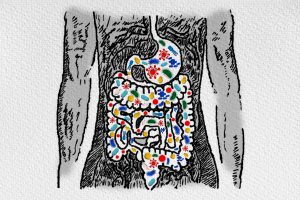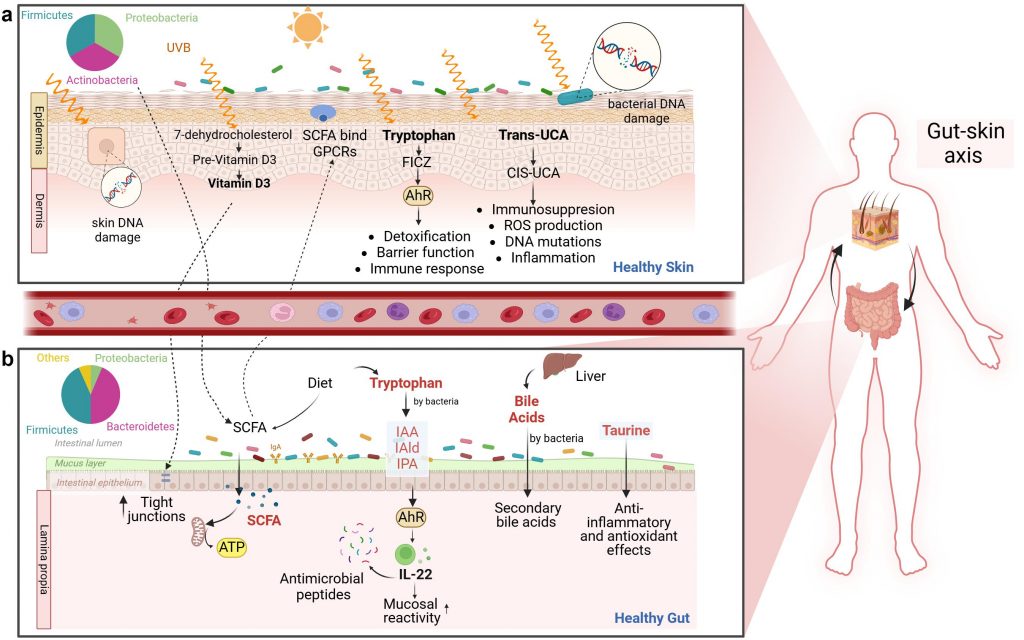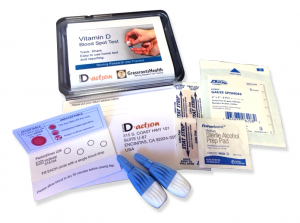Published on May 12, 2025
UVB from sunlight plays an important role in modulating the complex bi-directional gut-skin axis and our microbiome
Key Points
- A bidirectional relationship exists between the skin and the gastrointestinal (GI) tract, known as the “gut-skin axis” or GSA, in which the gut and skin microbiota play a central role in overall heath and disease. Sunlight exposure, particularly UVB light, affects both the gut and skin microbiomes and contributes to systemic health through their interrelated pathways.
- The GSA is mediated by molecules such as cytokines, microbial metabolites, hormones, and neurotransmitters, all of which work together to maintain tissue homeostasis and responses to potential systemic threats – many of which are influenced by sunlight
- UVB from sunlight plays an important role in modulating the complex bi-directional gut-skin axis. It alters local skin microbiota and immune signaling, promotes systemic production of vitamin D and AhR ligands, and leads to downstream changes in gut microbiota and immune responses—ultimately influencing the health of both the skin and gut.
Hot off the Press! The gut-skin axis: a bi-directional, microbiota-driven relationship with therapeutic potential by Jimenez-Sanchez et al.
 Your gastrointestinal tract and the surface of the skin are home to trillions of microbes (bacteria, viruses, and yeast) called your “microbiome,” which act as their own organ and are crucial to your overall health. Skin health is maintained by a balanced, diverse microbiome, which is in turn affected by nutrition, pH level, hygiene, exposure to toxins, barrier strength, stress levels, sunlight exposure, overall health, and more. The microbiome of both the skin and the gut can also directly contribute to our overall health.
Your gastrointestinal tract and the surface of the skin are home to trillions of microbes (bacteria, viruses, and yeast) called your “microbiome,” which act as their own organ and are crucial to your overall health. Skin health is maintained by a balanced, diverse microbiome, which is in turn affected by nutrition, pH level, hygiene, exposure to toxins, barrier strength, stress levels, sunlight exposure, overall health, and more. The microbiome of both the skin and the gut can also directly contribute to our overall health.
Many diseases have been associated with microbial dysbiosis, a term used to describe an imbalance in the microbiota community, and often due to reduced bacterial diversity and stability. These diseases and conditions extend beyond those affecting the GI tract (such as inflammatory bowel disease and irritable bowel syndrome) and include atopic asthma, mental health disorders including depression, schizophrenia, and addiction, obesity, type 2 diabetes, cardiovascular disease, and autoimmune diseases such as rheumatoid arthritis and multiple sclerosis.
The Gut-Skin Axis (GSA)
A 2025 paper by Jimenez-Sanchez et al. details the bidirectional relationship between the skin and the gastrointestinal (GI) tract, known as the “gut-skin axis” or GSA, in which the gut and skin microbiota play a central role in overall heath and disease. It also provides a comprehensive analysis of how sunlight exposure, particularly UVB light, affects both the gut and skin microbiomes and contributes to systemic health through their interrelated pathways. The following diagram provides an illustrated overview of these pathways.

How Sunlight Influences the Gut-Skin Axis
As can be seen in the diagram, the GSA is mediated by molecules such as cytokines, microbial metabolites, hormones, and neurotransmitters, all of which work together to maintain tissue homeostasis and responses to potential systemic threats – many of which are influenced by sunlight.
Specific wavelengths of sunlight help to protect the health of the skin through its influence on the skin microbiome. Both UVB and UVA from sun exposure affect the microbial diversity on the skin, benefitting the skin microbiome. When it comes to skin health, studies have shown that several molecules that help protect our skin from UV damage are produced by the microbiome on our skin upon UV exposure, acting as a sort of natural sunscreen. A study by Harel et al. (2023) examined the skin microbiome of lifeguards who were regularly exposed to longer periods of summer sun. They found that, after the summer season, there was an increased abundance of UV-resistant bacteria, which helped to protect the skin cells from damage through their production of anti-oxidative molecules.
The Role of Vitamin D
Sunlight exposure (specifically UVB) initiates several key biological responses that influence both the gut and skin ecosystems. One way is through the production of vitamin D within the skin, which has been shown to enhance gut health by reinforcing the intestinal epithelial barrier, boosting innate immune responses, and supporting a balanced gut microbiota. Previous research, such as that by Bosman et al, has demonstrated how vitamin D from both UVB exposure and supplemental intake can help modulate the composition of the gut microbiome, increasing diversity and the amount of beneficial bacteria.
“…we know that UVB light/radiation can significantly affect both the skin and gut. UVB stimulates the production of vitamin D in the skin, which, among its many roles, helps sustain a healthy gut microbiome, as deficiencies have been linked to microbial dysbiosis and IBD.”
UVB induced vitamin D production also increases the expression of antimicrobial peptides like cathelicidin in both skin and gut tissues and strengthens tight junction proteins in the gut epithelium, thereby reducing permeability and inflammation. Vitamin D synthesized in the skin can also activate vitamin D-receptor signaling in the gut. Each of these activities provide mechanisms through which vitamin D and/or UVB from sunshine helps regulate the gut microbiome and gut health.
Non-Vitamin D Mechanisms
In addition to vitamin D production, UVB radiation promotes the production of tryptophan-derived metabolites such as 6-formylindolo[3,2-b]carbazole (FICZ), which activate the Aryl hydrocarbon Receptor (AhR). AhR activation plays a crucial role in immune regulation and maintaining barrier function in both the skin and gut. For instance, AhR ligands increase IL-22 production, which modulates gut immunity and epithelial health. UVB-induced AhR activation in the skin has been shown to upregulate gene expression in the gut, further supporting a systemic communication loop mediated by light exposure.
Some studies report increased diversity and abundance of short-chain fatty acid (SCFA)-producing microbes following UVB exposure, though this appears dose- and duration-dependent. SCFAs such as butyrate, produced by gut microbes, are then transported systemically, where they bind to receptors on skin cells, influence skin immunity, and support barrier integrity.
Another activity induced by UVB exposure is the conversion of tryptophan into a molecule called 6-formylindolo [3,2-b] carbazole, or FICZ, which has a regulatory effect on several genes, especially those within the epithelial barriers and cells of the gut and skin associated immune system.
In Conclusion – Sunlight is Beneficial for Your SGA Microbiome and Health
UVB from sunlight plays an important role in modulating the complex bi-directional gut-skin axis. It alters local skin microbiota and immune signaling, promotes systemic production of vitamin D and AhR ligands, and leads to downstream changes in gut microbiota and immune responses—ultimately influencing the health of both the skin and gut. In conclusion, UVB light therapy could be used as a potential therapy for GI imbalances and illnesses, as well as systemic diseases that are associated with microbial dysbiosis.
This Sunshine Month, get 10% off your home blood spot test kit plus get our Sunshine eBook for free when using the code SunMonth25 at checkout.
 What happens in your body when it is exposed to sunlight?
What happens in your body when it is exposed to sunlight?
Watch this snippet of a video interview with Dr. Michael Holick, as he describes some of the reactions that happen within the body when it is exposed to sunlight.
 Supplements do not replace sunlight
Supplements do not replace sunlight
Sunlight has more benefits than those provided by UVB and vitamin D. Learn about the different rays found in sunlight and their unique benefits to your health.
 Can the benefits of sunshine exposure be replaced by a pill?
Can the benefits of sunshine exposure be replaced by a pill?
Watch this snippet of a video interview with Dr. Michael Holick, as he describes the multiple benefits of sunshine exposure, and why the health benefits of sunshine cannot be replaced.
Are You Getting Enough Vitamin D from Sunshine?
 Having and maintaining healthy vitamin D levels and other nutrient levels can help improve your health now and for your future. Choose which additional nutrients to measure, such as your omega-3s and essential minerals including magnesium and zinc, by creating your custom home test kit today. Take steps to improve the status of each of these measurements to benefit your overall health. With measurement you can then determine how much is needed and steps to achieve your goals. You can also track your own intakes, symptoms and results to see what works best for YOU.
Having and maintaining healthy vitamin D levels and other nutrient levels can help improve your health now and for your future. Choose which additional nutrients to measure, such as your omega-3s and essential minerals including magnesium and zinc, by creating your custom home test kit today. Take steps to improve the status of each of these measurements to benefit your overall health. With measurement you can then determine how much is needed and steps to achieve your goals. You can also track your own intakes, symptoms and results to see what works best for YOU.
Enroll in D*action and Test Your Levels Today!



 What happens in your body when it is exposed to sunlight?
What happens in your body when it is exposed to sunlight? Supplements do not replace sunlight
Supplements do not replace sunlight Can the benefits of sunshine exposure be replaced by a pill?
Can the benefits of sunshine exposure be replaced by a pill?


